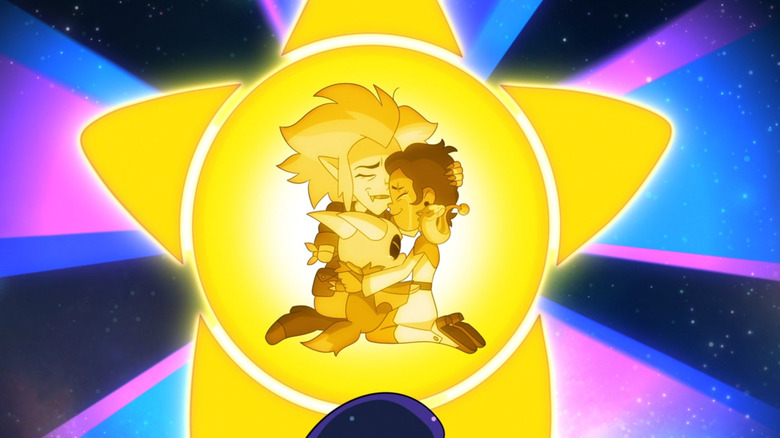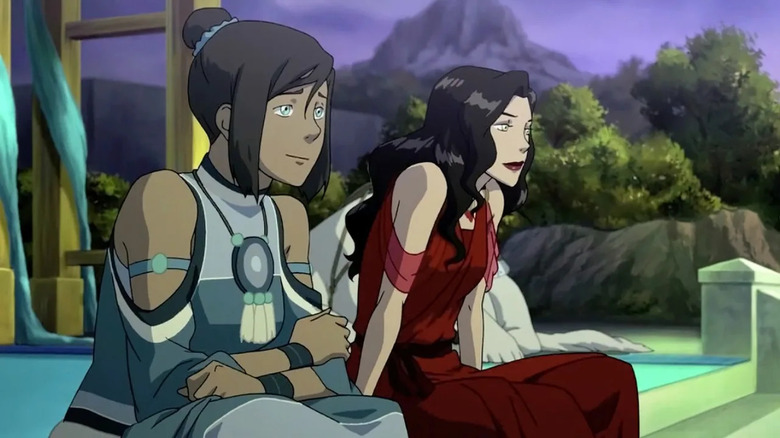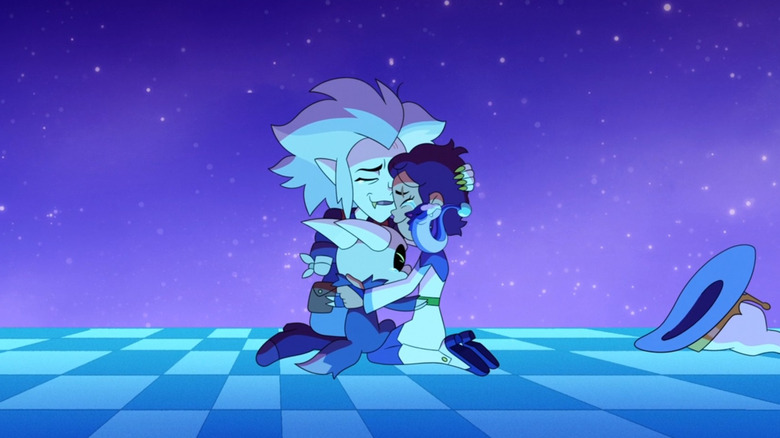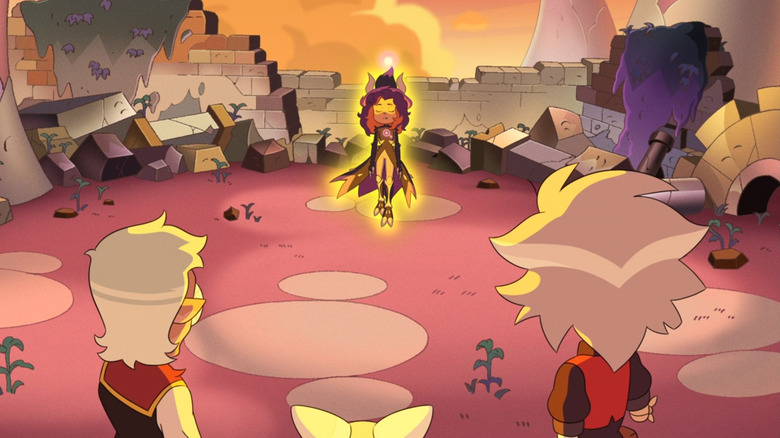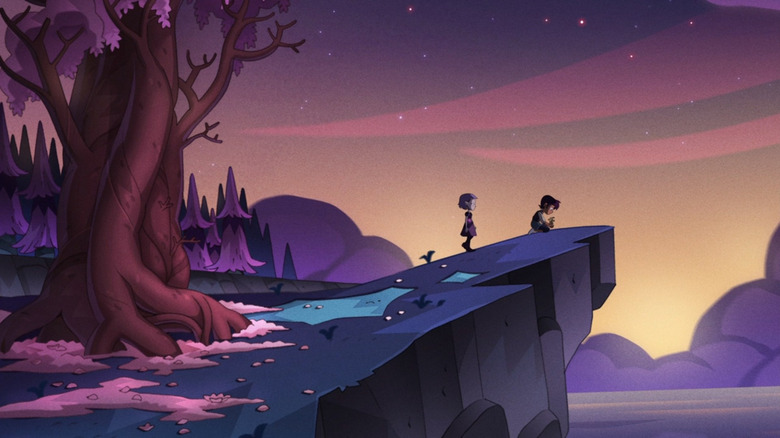The Owl House Was There For Me During The Pandemic, And TV Is Worse Without It
The Day of Unity has come and gone. We've reached the end of "The Owl House," and the end of an era. In its severely truncated third season, the Disney series covered more ground than it ever should have had to, and it has done so beautifully. Now, with its ending, a golden age for queer cartoons is over.
I started watching "The Owl House" in 2021. The show had just gone on mid-season hiatus for Season 2, and the all-powerful YouTube algorithm decided to feed me a constant stream of clips from it. I'm still not sure why. Perhaps it was my propensity for rewatching scenes from "Avatar: The Last Airbender" and "The Legend of Korra." Perhaps it was fate, or magic from the Boiling Isles. Regardless, I was hooked. The animation was gorgeous, the world was rich and intriguing, and most importantly, I found it calming. It was the strangest, most unexpected balm to the pandemic isolation and work-from-home grind in my small Brooklyn apartment. In a way I couldn't quite name, it was exactly what I needed.
I blew through all that there was in about two weeks and waited eagerly for Season 2 to return. But impatience got the better of me, and that's when the real binge began. "She-Ra and the Princesses of Power." "Amphibia." "Kipo and the Age of Wonderbeasts." Through "The Owl House," I discovered a whole world of spectacular queer cartoons that could've easily passed me by. Now, sadly, they're almost all gone.
This is a eulogy for "The Owl House," and for the other shows like it that are disappearing. It will probably get a little sentimental, or even downright sappy. But they were there for me when I needed them, and TV is worse with them gone.
A brief history of queer cartoons, leading to The Owl House
The first time I remember seeing LGBTQ+ representation in a kids' animated series was the ending of "The Legend of Korra." I was 18 when it ended, and I remember being shocked at the final shot of Korra and Asami holding hands. By today's standards, it was barely a crumb. But at the time, it broke the internet. I was aware of all the Korrasami shipping that went on in the fandom, and I saw the clues throughout Season 4 that it might actually happen. But it was still staggering to see — even with the frustrating limitations placed by Nickelodeon.
That wasn't the beginning of queer representation in cartoons. The incomparable "Steven Universe" had already been on the air for a year, and other smaller instances — more allusions than allowed canonical relationships — existed long before that. But it was my first time realizing just how rare LGBTQ+ cartoon characters were. It would be a few more years before I came into my own queerness, but "Korra" opened me up to the negative space I'd been blind to.
In the years after, I stopped watching cartoons, but they didn't stop pushing things forward. Bubblegum and Marceline in "Adventure Time." A crumb here and there in "Gravity Falls" or "Star vs. the Forces of Evil." And then, suddenly, an avalanche. "She-Ra;" "Kipo;" "Infinity Train;" "Dead End: Paranormal Park;" "The Owl House." You could call it an embarrassment of riches, but only if you chose to ignore the long history of queer erasure in children's media.
All of those shows are over now. And while cartoons aren't entirely devoid of queer characters today, it's hard not to feel like a whole era has suddenly passed us by.
What made The Owl House special?
"The Owl House" wasn't supposed to be over today. It was supposed to have a full Season 3 to finish guiding its characters through their journeys. According to creator Dana Terrace, Disney canceled the show because it didn't fit the company's brand for animated children's programming. You can interpret that in any number of ways, but the result is the same: a series that had to sprint to the finish line in just three double-length specials when it should have had a marathon and a victory lap.
But rather than mourn what could have been, let's celebrate what "The Owl House" brought us. At its core, it's about the inherent beauty in diversity. It proclaims proudly and often that the mere act of living authentically, in a way only you can, is a valorous one. "Us weirdos have to stick together," is a mantra spoken often in the show. The twist, of course, is that everyone is a weirdo.
Not all of this is queer allegory. "The Owl House" is far too expansive in its emotional reach to be limited to just one "thing," just as Luz Noceda is too ambitious of a witch to choose just one field of study at Hexside. Rather, every distinct piece helps construct a world where queerness feels as natural as breathing. It treats each character's emotional life with the same nuance and complexity as the core plot. And it imagines a place where joy, not fear, dictates how people live their lives.
What I learned from Luz Noceda
I wanted to write about "The Owl House" because it changed me. It helped me claim my own queerness — not as a title, but as a totality of how I move through the world. And in the middle of a global pandemic, it also helped me find peace and avenues of optimism while the "adult" world around me sank deeper into panic.
Queer cartoons weren't the only TV trend of the 2010s. Another, led by "Game of Thrones" and "Breaking Bad," saw hyper-serious prestige dramas come to dominate the space of "grown-up" entertainment. Looser regulations for cable and streaming series opened the floodgates for more sex and violence, and an overriding pessimism followed suit.
In the Covid era, I found myself moving away from these shows. What good was escapism when fiction was as depressing as reality? There are a ton of great dramas on HBO and Netflix, but they weren't for me. Not in the summer of 2021 when I started watching "The Owl House."
Luz's journey isn't a utopian fantasy. Quite the contrary, the show deals heavily with themes of trauma, failure, and shame. Things get bad. Evil people win. But with the help of her friends, Luz always manages to find the brighter angle. Her superpower is the ability to stay true to herself, even in a cruel world.
We need more shows like The Owl House
It's a good day to celebrate the legacy of "The Owl House," but a sad day to realize it closed the door on its way out. Executive shake-ups at Disney, financial woes at Netflix, and the neverending chaos of the Warner Bros. Discovery merger have left three of the biggest cartoon platforms on uncertain terrain. For now, there's no clear successor to take the baton from "The Owl House."
We need more shows like "The Owl House," not fewer. We need every kid to be able to see themselves in their favorite adventures. We need stories that imagine the creation of better worlds out of broken ones. I sometimes wonder how I might have turned out different if I'd had "The Owl House" to watch as a kid, alongside "Avatar" and "Teenage Mutant Ninja Turtles." Fortunately, as is true in Luz's world, censorship can't stop people from finding themselves.
At the end of "Watching and Dreaming," the "Owl House" series finale, the Boiling Isles are devastated by battle. But it's a victory. As the closing credits roll, we get a gorgeous montage set a few years later, with Luz and the gang all entering young adulthood. Everyone, it seems, has found their place in the world. I hope that all the kids who watched "The Owl House" will feel the same in years to come. I hope that, like Korrasami, we'll look back on it as a groundbreaking achievement, but also as just one piece of a long and ongoing legacy.
